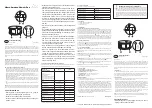
The selected memory byte cannot be used for temporary data storage.
n
Number of Memory bytes from MB0
–
Enter the number of retentive memory bytes from memory byte 0 onwards.
n
Number of S7 Timers from T0
–
Enter the number of retentive S7 timers from T0 onwards. Each S7 timer occu-
pies 2bytes.
n
Number of S7 Counters from C0
–
Enter the number of retentive S7 counter from C0 onwards.
n
Areas
–
This parameter is not supported.
n
Priority
–
Here the priorities are displayed, according to which the hardware interrupt OBs
are processed (hardware interrupt, time-delay interrupt, async. error interrupts).
n
Priority
–
This value is fixed to 2.
n
Active
–
By enabling
‘Active’
the time-of-day interrupt function is enabled.
n
Execution
–
Select how often the interrupts are to be triggered.
–
Intervals ranging from every minute to yearly are available. The intervals apply to
the settings made for
start date
and
time
.
n
Start date/time
–
Enter date and time of the first execution of the time-of-day interrupt.
n
Process image partition
–
This parameter is not supported.
n
Priority
–
Here the priorities may be specified according to which the corresponding cyclic
interrupt is processed.
–
With priority "0" the corresponding interrupt is deactivated.
n
Execution
–
Enter the time intervals in ms, in which the watchdog interrupt OBs should be pro-
cessed.
–
The start time for the clock is when the operating mode switch is moved from
STOP to RUN.
n
Phase offset
–
Enter the delay time in ms for current execution for the watch dog interrupt. This
should be performed if several watchdog interrupts are enabled.
–
Phase offset allows to distribute processing time for watchdog interrupts across
the cycle.
n
Process image partition
–
This parameter is not supported.
Retentive Memory
Interrupts
Time-of-day interrupts
Cyclic interrupts
System 300S
+
Deployment CPU 315-4PN23
Setting standard CPU parameters > Parameters CPU
HB140 | CPU | 315-4PN23 | en | 18-02
46
















































